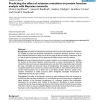66 search results - page 3 / 14 » Incremental Bayesian networks for structure prediction |
IJAR
2008
13 years 7 months ago
2008
When an incremental structural learning method gradually modifies a Bayesian network (BN) structure to fit observations, as they are read from a database, we call the process stru...
ETFA
2008
IEEE
13 years 8 months ago
2008
IEEE
Microshrinkages are known as probably the most difficult defects to avoid in high-precission foundry. Depending on the magnitude of this defect, the piece in which it appears must...
IWANN
2009
Springer
14 years 1 months ago
2009
Springer
Abstract. Microshrinkages are known as probably the most difficult defects to avoid in high-precision foundry. The presence of this failure renders the casting invalid, with the su...
PSB
2008
13 years 8 months ago
2008
bstracts in the structure prior of a Bayesian network could improve the prediction of the prognosis in cancer. Our results show that prediction of the outcome with the text prior w...
BMCBI
2006
13 years 7 months ago
2006
Background: A number of methods that use both protein structural and evolutionary information are available to predict the functional consequences of missense mutations. However, ...

